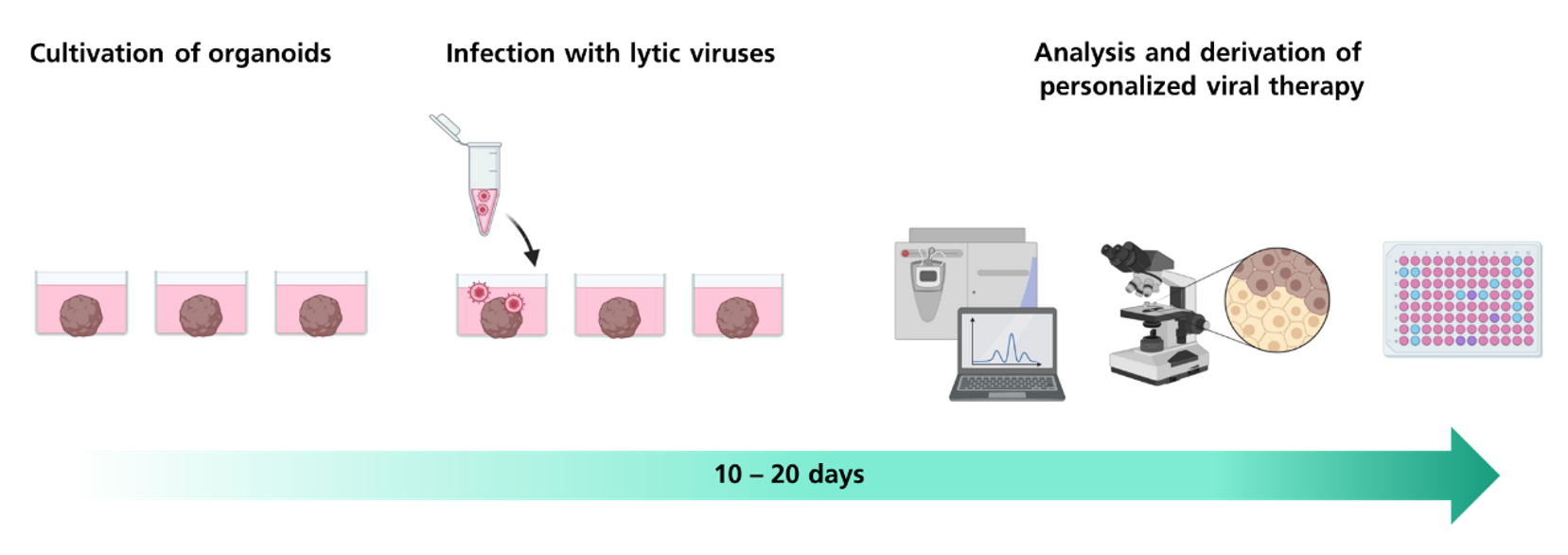Therapeutic viruses are currently experiencing a tremendous boom for gene and cancer therapy. However, data from preclinical studies of virotherapies are currently of limited value, as mainly 2D cell systems are used for their analysis. In this project, an infection model for the kinetic analysis of virotherapies is now being established on the basis of a neuronal organoid, which is suitable as a simple, cost-effective and mass-market platform procedure for testing therapeutic viruses.
KinVOid – Kinetic analysis of virotherapy in the 3D organoid model
Virotherapies are currently experiencing an enormous boom and will be of central importance in the future. Viruses and viral vectors are already being used in cell and gene therapy, as well as oncolytic viruses in cancer therapy, but the many possible applications of virotherapy are far from exhausted. Currently, the data from the preclinical studies of virotherapy are only of limited significance, since up to now mainly 2D cell systems have been used for their analysis. These 2D systems do not adequately reflect the complex in-vivo situation in terms of efficacy, safety and dosage [1]. Furthermore, the "one size fits all" principle still applies to virotherapy, which hinders effective personalized use.
Meaningful tests using organoids
Organoids represent innovative, preclinical 3D test systems for virotherapy, which will even enable personalized tests in the future through the use of patient material (patient-derived organoids). With KinVOid, the first steps were taken towards the development of a simple, inexpensive and mass-market platform procedure for testing therapeutic viruses. Based on a herpesviral infection of neuronal organoids as a model, the kinetics of viral infection of (tumor) organoids will be determined using an inline proteome analysis in combination with viral detection methods.
Virus analysis in the infection model
As part of this project, the cultivation of neuronal organoids and an infection model adapted to them could be established in cooperation with Fraunhofer IPA. This includes determining an appropriate amount of virus for infection and the duration of infection. The organoids could be examined microscopically for morphological changes and the viability could be monitored several days after infection. The investigation of the organoid-based infection model was also expanded to include a novel virus analysis using mass spectroscopy. This enabled pioneering investigations into the kinetic penetration of organoids with therapeutic viruses.
As a result, a workflow for further studies based on the organoid model for personalized oncolytic virotherapies was established, which can be used for other areas of theranostics, i.e. therapy aimed at precise diagnostics. An automated mass spectrometric analysis of the virus infection in the model also enables patient-specific therapy, in which the amount of active ingredient and the therapeutic strategy can be adjusted with little effort.

Literature
[1] D´Aiuto, Leonardo; et al (2019) Modeling herpes simplex virus 1 infections in human central nervous system neuronal cells using two- and three-dimensional cultures derived from induced pluripotent stem cells, J Virol 93:e00111-19
Project information
Project title
KinVOid – Kinetic analysis of virotherapy in the 3D organoid model
Project duration
May 2022 – August 2022
Project partners
- Fraunhofer Institute for Interfacial Engineering and Biotechnology IGB
- Fraunhofer Institute for Manufacturing Engineering and Automation IPA (Traube, Graeve, Bhuvaneshwaran)
Project coordination
- IGB, Funk/Bailer
- IPA, Graeve/Traube
Funding
- BaWü Innovation project
- High Performance Center Mass Personalization LZMP
 Fraunhofer Institute for Interfacial Engineering and Biotechnology IGB
Fraunhofer Institute for Interfacial Engineering and Biotechnology IGB